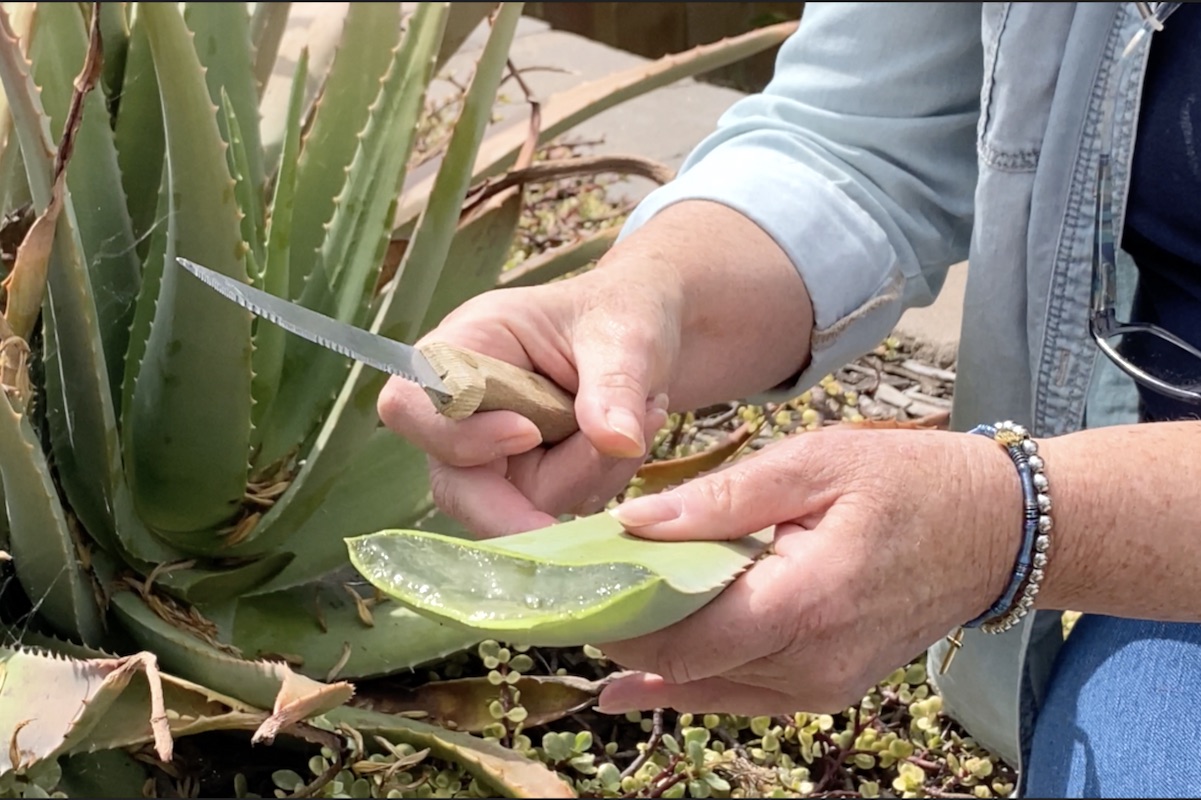
Why You Should Grow Aloe Vera
Should you grow Aloe vera in your garden as an ornamental plant and harvest its medicinal leaves?
Yes, but do heed important cautions below.
Aloe Vera benefits
Aloe vera is the most widely grown herbal succulent because of its soothing, medicinal gel. But did you know that the plants are easy to grow and look great in gardens? Here and in my new video, I show Aloe vera in residential applications from Honolulu to Phoenix, and in a SoCA landscape with mature specimens in bloom---by the hundreds!
I explain how to grow Aloe vera and harvest the gel, correct common misconceptions, and even share a recipe. You'll also learn about aloin, the rind's bitter yellow sap---essential knowledge for anyone allergic to latex.
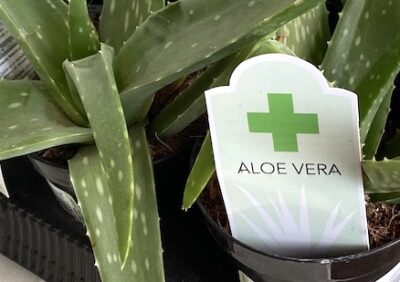
Aloe vera plants are available at many nurseries, garden centers and farmer's markets
You can also grow this herbal succulent in pots. It makes a good windowsill plant, although it's unlikely to bloom indoors. Under ideal conditions plants get several feet tall and about as wide.
Aloe gel has numerous health claims, some astonishing. I'll never forget the kind, caring Hispanic women I worked with who brought fresh aloe leaves to our boss, after learning he was terminally ill. No miracle happened, but I still wonder if it would have made a difference if they'd brought them earlier.
Aloe vera is one of the most commercial succulents, and dozens of companies process and use the gel in lotions and health-promoting products. Aloe vera is most famous for its topical use for minor burns and skin irritations. The gel also is high in vitamin C and amino acids, and has antibiotic properties.
Commercial aloe gel is purified and stabilized, and lacks the sliminess of raw gel.
That's the right name
Legend has it Aloe vera gel was used by the ancient Chinese to treat burns and wounds, by Cleopatra as a skin moisturizer and softener, and by Alexander the Great to treat injured soldiers.
Aloe vera is no longer found in habitat, but as most aloes, it likely originated in Africa. It’s sometimes called Aloe barbadensis because it has naturalized on Barbados, but that name is incorrect; no aloes are native to the Americas.
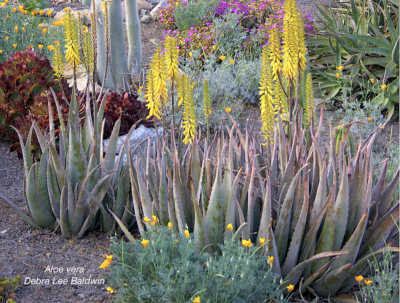
Aloe vera cautions
Aloes contain the chemical aloin which causes skin irritation and contact dermatitis in those allergic to latex.
Aloin is the yellow sap found just inside the rind, between the outer skin and the inner gel. Even if you're not allergic to latex, when ingested, aloin can cause cramping and diarrhea.

Aloin shows as a yellow ring when the cut edge of an aloe leaf is blotted onto a paper towel
When scooping gel from the leaf, avoid getting close to the rind where the yellow latex is. (See video.) Use plump, juicy green leaves. Dehydrated leaves have a higher aloin-to-gel ratio.
Safely prepare raw gel
I'm not allergic to latex, so I use raw aloe gel straight from the leaf to soothe minor burns, skin irritations (like insect bites), and sunburn. But eating it is a different matter.

Soak freshly harvested aloe gel in water.
To avoid ingesting aloin, after scooping gel from the center of a leaf, I cover raw gel with water. If it turns yellow, I change the water until it stays clear.
Simple aloe smoothie
When properly harvested and prepped, raw gel should taste more bland than bitter. Eat it as is or mix with water or juice (it's chunky so it'll need to be blended). Start with small quantities to gauge how well you tolerate it.
For a delicious smoothie:
- 1/4 c. raw aloe gel
- 1 ripe banana
- half a dozen fresh or frozen strawberries
- 1 cup coconut or almond milk
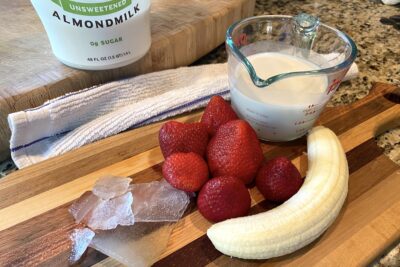
Aloe vera smoothie ingredients include raw gel (after soaking) at left.
Aloe vera in the landscape

Aloe vera at a strip mall in Southern CA
In the garden, Aloe vera is an easy-care, ornamental, low-water plant. Instead of orange flowers typical of the majority of aloes, those of Aloe vera are yellow. Leaves are tapered, upright, gray-green, and get about waist-high. I like it best against a solid-colored backdrop. Find more design ideas in the video.
Care and propagation
Aloe vera is colony-forming over time. Allow it to spread slowly on its own, or remove offsets from the base of the plant to give away or transplant elsewhere in your garden.

Aloe vera thrives in a back yard near Honolulu
Grow Aloe vera outdoors if you live in Zones 8 to 11. It does fine in climates normally too humid for succulents, such as Hawaii and Florida, as well as those that are dry and hot, like southeastern CA and Arizona. Protect from frost.

Aloe vera in Rich Zeh's garden near Phoenix
Give Aloe vera plenty of sun, and soil that drains well. Like all succulents, aloes survive drought by drawing on stored moisture. If you want leaves to stay plump juicy, water plants during the dry season (which in North America is summer and fall).
Other medicinal aloes
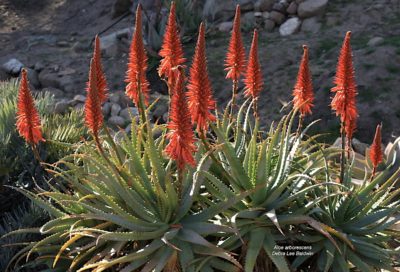
Aloe arborescens
Aloe arborescens (above), a popular landscape succulent, offers benefits similar to Aloe vera.
Although many aloes have medicinal properties, not all do. In fact, some aloes are poisonous. Duke Benadom of the Los Angeles Cactus & Succulent Society (author of Superb Succulents) researched and compiled this list of medicinal aloes (in blue) and poisonous aloes (in red). Those with an asterisk are treelike.
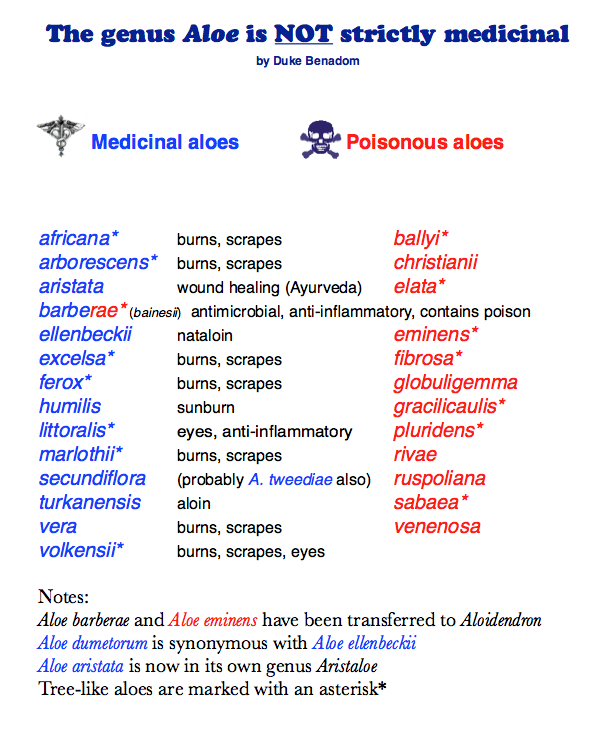
List reproduced with permission.
***Please note: This article is for educational purposes only. I am neither a culinary professional nor a medical herbalist. I take no responsibility for any allergies, stomach upset or other concerns that might result from using aloe gel. Links may be affiliate. -- Debra Lee Baldwin***
Related info on this site
All About Aloes
Ah, aloes! No other succulents add so much color, interest and drama to low-water, mild-climate gardens. Aloes are easy to grow and bloom mainly in winter when nothing else does. The number of Aloe varieties is ever-increasing, with lovely new cultivars continually being introduced.
Ten Edible Succulents and How to Prepare Them
These ten edible succulents can go from garden to kitchen. Most are fairly easy to obtain, cultivate and prepare. The mucilaginous (goopy) texture of certain edible succulents makes them—to spin it positively—great in soups and stews. Vitamin C is


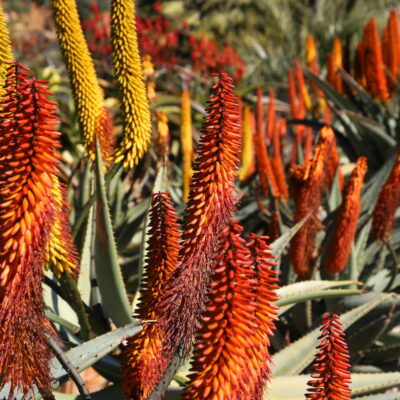

You are awesome! Thank you for being you!
Aw thanks, Bonnie!
[…] © Debra Lee Baldwin […]